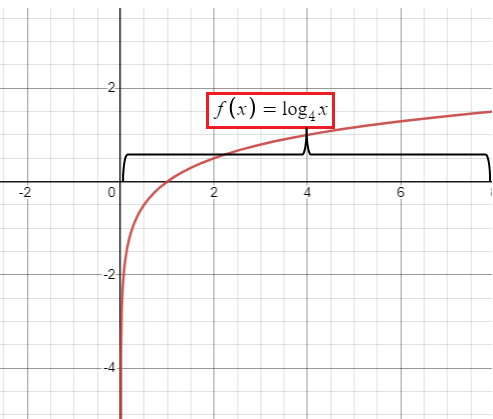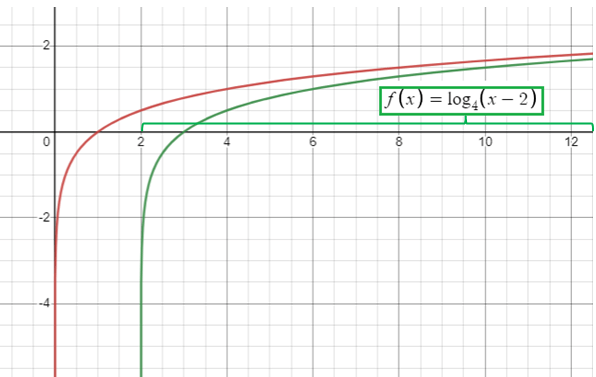FIND DOMAIN RANGE X AND Y INTERCEPT IN LOGARITHMS
The logarithmic function is the inverse of exponential function.
f(x) = loga(ax + b) + c
Finding domain :
Domain is set of all possible defined values of x. To find domain of logarithmic function, we can use the procedure given below.
Step 1 :
Take the argument and create the condition,
(ax + b) > 0
Step 2 :
Get the possible values of x from the above condition.
For example,
|
f(x) = log4 x x > 0 |
 |
|
f(x) = log4(x-2) x - 2 > 0 x > 2 |
 |
Range :
Set of possible values of y is range.
x-intercept :
The curve where it is intersecting the x-axis is known as x-intercept. To find x-intercept, we have to set up y to 0.
y-intercept :
The curve where it is intersecting the y-axis is known as y-intercept. To find y-intercept, we have to set up x to 0.
For the following exercises, state the domain, range, and x- and y-intercepts, if they exist. If they do not exist, write DNE.
Problem 1 :
h(x) = log4(x - 1) + 1
Solution:
Considering the parent function as f(x) = log4x
the given function h(x) = log4(x - 1) + 1
should be translated 1 unit to the right and 1 unit up.
Finding domain :
To find domain, we have to set up the condition argument > 0
x - 1 > 0
x > 1
Finding range :
All real numbers.
x-intercept:
h(x) = 0
0 = log4(x - 1) + 1
log4(x - 1) = -1
x - 1 = 4-1
x - 1 = 1/4
x = 1/4 + 1
x = 5/4
x- intercept = (5/4, 0)
y- intercept:
x = 0
h(x) = log4(0 - 1) + 1
h(x) = log4(-1) + 1
Does not exist
Problem 2 :
f(x) = log(5x + 10) + 3
Solution:
Domain:
5x + 10 > 0
5x > -10
x > -2
Domain: {x € R |x > -2}
Range:
The range of the function is set of real numbers.
x- intercept:
y = 0
0 = log(5x + 10) + 3
log(5x + 10) = -3
5x + 10 = 10-3
5x + 10 = 1/103
5x + 10 = 1/1000
5x = (1/1000) - 10
5x = -9999/1000
x = -9999/5000
y- intercept:
x = 0
y = log(5x + 10) + 3
y = log(5(0) + 10) + 3
y = 4
Problem 3 :
g(x) = ln(-x) - 2
Solution:
g(x) = ln(-x) - 2
Domain:
-x > 0
x < 0
Domain: (-∞, 0)
Range:
All real numbers
x- intercept:
y = 0
ln(-x) - 2 = 0
ln(-x) = 2
-x = e2
x = -e2
y- intercept:
x = 0
g(x) = ln(0) - 2
Does not exist.
Problem 4 :
f(x) = log2(x + 2) - 5
Solution:
f(x) = log2(x + 2) - 5
Domain:
x + 2 > 0
x > -2
Domain: (-2, ∞)
Range:
All real numbers
x- intercept:
y = 0
log2(x + 2) - 5 = 0
log2(x + 2) = 5
x + 2 = 25
x + 2 = 32
x = 32 - 2
x = 30
y- intercept:
x = 0
f(0) = log2(0 + 2) - 5
= log2(2) - 5
= 1 - 5
f(0) = -4
Problem 5 :
h(x) = 3ln(x) - 9
Solution:
h(x) = 3ln(x) - 9
Domain:
x > 0
Domain: (0, ∞)
Range:
All real numbers
x- intercept:
y = 0
3ln(x) - 9 = 0
ln(x) = 9/3
ln(x) = 3
x = e3
y- intercept:
x = 0
h(0) = 3ln(0) - 9
Does not exist.
Recent Articles
-
Finding Range of Values Inequality Problems
May 21, 24 08:51 PM
Finding Range of Values Inequality Problems -
Solving Two Step Inequality Word Problems
May 21, 24 08:51 AM
Solving Two Step Inequality Word Problems -
Exponential Function Context and Data Modeling
May 20, 24 10:45 PM
Exponential Function Context and Data Modeling